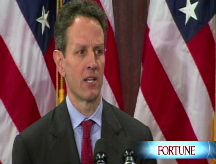The audacity of hopelessness
Investors have little faith in Washington right now. And even though stimulus and the new bank bailout may eventually work, the lack of trust seems warranted.
NEW YORK (CNNMoney.com) -- So much for change you can believe in.
Last year, the market had no confidence that President Bush, Treasury Secretary Henry Paulson and a more evenly split Congress had the answers for the credit crunch and recession.
And so far in 2009, investors seem to feel the same way about President Obama, Treasury Secretary Tim Geithner and a Congress with a bigger Democratic majority.
I think noted market sage Jon Bon Jovi put it best: "It's all the same...only the names have changed."
Despite all the hype about the stimulus bill and Geithner's new Financial Stability Plan (or FSP -- pronounced foospah to rhyme with chutzpah, perhaps?), investors are worried that this recession is going to last a lot longer and get even worse.
In particular, there are concerns that the Obama administration is unable to piece together a cohesive plan to fix the economy -- a criticism that dogged Bush and Paulson as well.
"This still has the semblance of an ad hoc architecture. It feels like more of the same," said Quincy Krosby, chief investment strategist with The Hartford.
For example, the biggest problem that investors seem to have with Geithner's proposal is that it still doesn't address the key issue plaguing banks: how much the spoiled assets on their books are really worth.
Paulson failed to do this -- even though the original intent of the Troubled Asset Relief Program was to buy up toxic assets tied to mortgages. And all Geithner has really done is create a template that allows private investors to take part in the process of ridding banks of their junk.
But now, nearly five months after Lehman Brothers imploded, investors want specifics.
"We need greater direction out of the Treasury," said Matt O'Reilly, chief investment strategist with People's United Wealth Management, in Bridgeport, Ct. "I don't think anybody truly has a handle of how wide the extent of this financial crisis was around the world. The issue continues to be how do you price these assets and what will the cost be to remove them."
Jeffrey Saut, chief investment strategist for Raymond James, added that investors are tired of not knowing for certain what Treasury plans to do to get credit flowing again.
He argues that the lack of clarity and consistency is causing investors to simply buy and sell based on whatever the latest rumor is about possible new plans.
"Investors don't know what the rules are because they keep changing like dirt under your feet in an earthquake. It's very tough to have a high degree of conviction so people have become traders," he said.
As for stimulus, investors seem to be disappointed with how watered down it has become.
"The stimulus package didn't grab investors' imagination. Investors wanted to see something in the bill that would convince them people would want to go out and spend as soon as possible," Krosby said, adding that she did not think the temporary tax credits for homebuyers and car buyers are big enough to have the desired effect.
Of course, this is not to say that stimulus and the new bank bailout, as well as all the actions taken by the Treasury and Federal Reserve in the past year, won't eventually help the economy.
But any programs of this magnitude will take time to work. And time is the enemy in an economy and market where people want improvement now.
"We need to see the employment numbers stabilize and corporate earnings improve," said O'Reilly. "Until then, the markets are going to continue to watch the news from Washington and be cautious and conservative."
Krosby agreed. Even though experts often say that the market anticipates a recovery and starts to rally ahead of it, this may not be the case this time around given all the uncertainty.
"People are looking for signs that the economy will pick up. At some point, investors will see those signs. But we're not there yet," she said. ![]()



